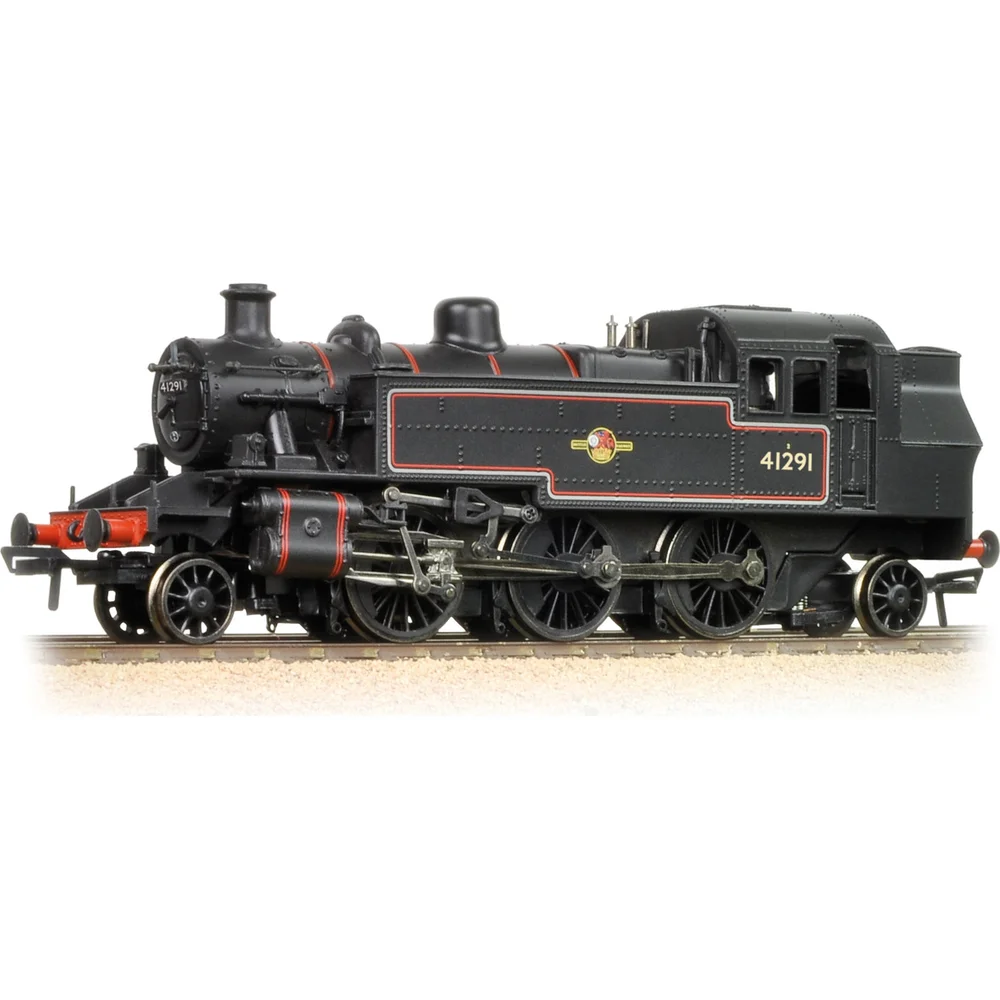Bachmann 31-441DC
London, Midland & Scottish Railway Ivatt Class 2 2-6-2T 41291 British Railways Lined Black with Late Crest
Tooling
In 2016, Bachmann Branchline unveiled a completely retooled model of the LMS Ivatt Class 2MT 2-6-2T, replacing its original 1995 tooling. This new version was designed to meet modern standards in detailing, performance, and digital compatibility. The prototype, designed by H.G. Ivatt, was introduced in 1946 for mixed-traffic duties and became a staple on branch lines across LMS and later British Railways regions. The 2016 model reflects the preserved examples and operational history with enhanced fidelity.
Tooling Features
- Scale: OO Gauge (1:76)
- Construction: Plastic bodyshell with fine separately fitted details
- Detailing: Turned brass safety valves and whistle, separately fitted handrails, pipework, bufferbeam details, and cab interior
- Couplings: NEM pockets with tension lock couplings
- Finish: Chemically blackened wheels and correct-thickness stamped rods
Mechanical & Electrical Specification
- Chassis: Lightweight chassis with loco-driven wheels
- Motor: Coreless motor located in the locomotive body
- Drive: Drive to two powered axles
- Minimum Radius: Compatible with Radius 2 curves (438mm)
- Weighting: Internal chassis weighting for improved adhesion
- Electrical Pickup: Driving wheels only
- Lighting: No factory lighting; firebox glow and other effects can be added via DCC
DCC Capability
The 2016 tooling is fully DCC Ready with an 18-pin socket located under the cab roof. While no speaker is pre-installed, there is space in the boiler for a sugar cube speaker, making sound installation straightforward. The model supports advanced decoder features including firebox glow and directional lighting when fitted with appropriate hardware. Sound-fitted versions have been released using Zimo decoders.
Liveries Produced
- LMS Black (1923–1947)
- BR Black with British Railways Lettering (1948–1951)
- BR Black with Early Emblem (1949–1957)
- BR Black with Late Crest (1957–1968)
- Preservation Liveries (e.g., KWVR Maroon)
Reviews & Commentary
The 2016 model received widespread praise for its accuracy, smooth running, and ease of DCC installation. Reviewers highlighted the crisp lining, flush glazing, and realistic valve gear motion. The coreless motor offers quiet and reliable performance, though some users noted the lack of tender pickups as a minor drawback. Overall, the model is considered a significant upgrade over the 1995 version.
Media & Social Media
Model railway forums and YouTube channels have featured the 2MT extensively, especially in DCC sound installation guides and layout running sessions. The model is popular among enthusiasts recreating BR branch lines and preservation scenes. The YouChoos installation guide for sound and firebox glow is particularly well-regarded for its clarity and ease of use.
Video Reviews
- Sam’s Trains Review – "Rip-Off Bachmann Ivatt 2MT Tank Engine"
- SDJR7F88 Review – "Bachmann 31-440 Ivatt Class 2MT 2-6-2 Tank"
- Hornby Magazine Review – "HM111: Bachmann re-chassised Ivatt '2MT' 2-6-2T"
Additional Notes
Accessory packs include optional bufferbeam details, vacuum pipes, and cosmetic couplings. The model is compatible with standard OO gauge track and controllers. Replacement parts and upgrade kits are available through Bachmann’s spares service and third-party suppliers.
Bachmann's Description & Specifications
Featuring a detailed and true-to-prototype bodyshell coupled with a high performance chassis, which is driven by a five pole motor and complete with a Next18 DCC decoder socket and space for a speaker, this model is sure to be popular with LMS enthusiasts and adds another tank engine to the LMS locomotive fleet.
Class & Prototype
- Class: London, Midland & Scottish Railway Ivatt Class 2 2-6-2T
- Traction: Steam
- Built: 1946-1952
- Total Built: 130
- Running Number: 41291
Operator & Livery
- Operator: British Railways
- Livery: Lined Black with Late Crest
- Era: 5 - British Railways Late Crest
British Railways transformed Britain's fragmented rail network into a unified national system following nationalisation on 1st January 1948. Created from the "Big Four" companies under the Transport Act 1947, BR operated most of Great Britain's railways until rebranding as British Rail in 1965, managing over 20,000 route miles and inheriting nearly 20,000 locomotives of diverse designs.
The organisation pioneered standardisation through its revolutionary BR Standard locomotive programme (1951-1960), producing 999 advanced steam engines under Robert Riddles' direction. These included the versatile Britannia Pacifics, mighty 9F freight engines, and mixed-traffic classes that incorporated the best features from all predecessor companies. The 1955 Modernisation Plan accelerated diesel and electric traction development, creating fascinating mixed-traction operations.
Notable achievements included establishing unified locomotive classification systems, introducing distinctive corporate liveries, and managing the complex transition from steam to modern traction. BR's six regional structure preserved operational diversity whilst enabling standardisation of practices, signalling, and rolling stock that had eluded private enterprise for over a century.
The BR era represents steam traction's final flowering alongside emerging diesel technology, creating unparalleled locomotive variety. Today, this heritage remains highly popular with railway enthusiasts through extensive preserved fleets, heritage railway operations, and comprehensive model ranges from manufacturers like Hornby, Bachmann, and Dapol, making BR subjects essential for authentic post-war British railway modelling across all scales.
